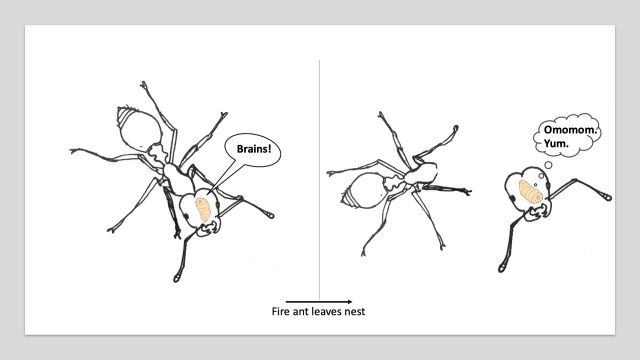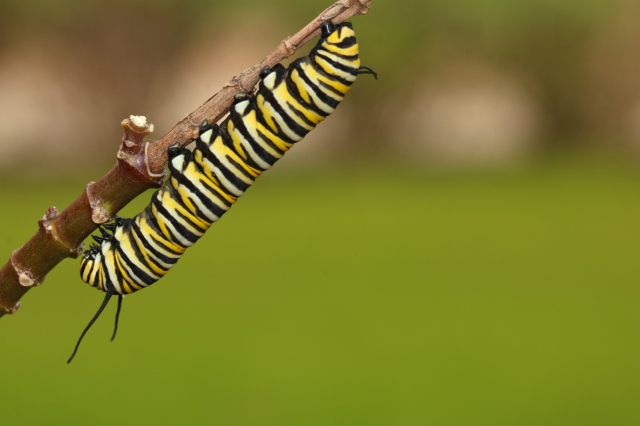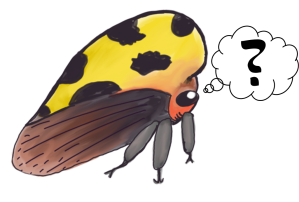Hello there! I’m Joanie Mars, or rather professionally, Joanie King. I typically prefer my alias “Mars” because “King” has always been a strange last name for me to identify with. You see, it’s not my stepfather’s last name and he’s been my dad since I can remember. Although Mars isn’t his last name, it’s a name that found me years ago (another story for another day). So, pardon me if I ever use them interchangeably. This is something I wanted to explain because it’s a point of confusion for people in my professional and personal life that discover “Mars” isn’t actually my last name. Though, I find it amusing that some do think it’s my last name.
Whew. Glad that’s out of the way!
The main goal of this blog post is to re-introduce myself here at Ask an Entomologist and write about what I’ve been up to over the past year. Before I begin the latter, I will discuss my past history that led me down the path to entomology. Although I’ve always liked insects and other animals, I didn’t think about becoming an entomologist until later in life, which was during my senior year of my undergraduate degree.
I have my Bachelor of Science in Biology from the University of Central Florida (UCF). It made sense to go to UCF because I grew up in Orlando and their Biology Department had opportunities for marine ecology and conservation. I wanted to become a marine biologist, therefore, this was very appealing. As I became more involved with undergraduate research, outreach/service learning, and volunteer work (under the guidance of the amazing Dr. Linda Walters), I realized that I would have to attend and complete graduate school if I wanted to continue scientific research, learning, and teaching. I had to figure out a lot what that meant as I went through college because no one in my immediate family went to college. One aspect I discovered was an important component of applying to graduate school is to have letters of recommendation. Typically, three letters are needed. I knew I could get two solid recommendation letters but that I’d need a third. I didn’t want the letter to come from a professor whom I had no personal experience or rapport. During the time I was investigating this, I was taking a Conservation Biology class with Dr. Joshua King (no relation). One day he made an announcement that he was looking for student volunteers for his insect ecology lab. What a perfect opportunity! Little did I know it would change the course of my life and career choice forever. While working in his lab, he and his graduate students taught me about the wonderful world of insects – especially ants. Ants are so cool. Their behavior, morphology, evolution, and ecology are extremely fascinating. After graduating I worked as a technician/research assistant in Dr. King’s lab for about a year. While working in Dr. King’s lab, I looked into grad school for entomology. I found and applied to a master’s student position researching fire ants at the University of Georgia (UGA) in Dr. Brendan Hunt’s lab. This position also worked closely with Dr. Kenneth Ross’ lab. At UGA I gained knowledge and confidence to push myself further down the path to becoming an entomologist. I had the pleasure of working with not only Brendan but many other entomologists and scientists. It was at UGA where I met Nancy Miorelli (I met Joe Ballenger later) and we shared our passion of outreach and teaching. I also received formal training in teaching. I taught a variety of labs and even taught the study abroad class, Insect Natural History in Ecuador. I’d be remiss if I didn’t also mention Dr. Joseph McHugh’s insect taxonomy class. Thanks to Joe, I learned how to identify and pronounce arthropod scientific names – which means a lot to this day because I have dyslexia and it was difficult for me. Very sharp learning curve for me!
I’m currently a PhD candidate at Texas A&M University in Dr. Edward Vargo’s lab. When I first wrote this sentence, I started with, “I’m a PhD student,” and then remembered that I passed my PhD candidacy in March of this year. It feels like pre-COVID-19 era, but really, it’s right before things began to really hit North America. Anyway. What is PhD candidacy? Simply put, PhD candidacy examination is a type of comprehensive exam also called “comps,” preliminary exams (“prelims”), or qualifying exams (“quals”). It varies from university to department on what’s involved, but typically happens before beginning the dissertation (which is basically a thesis with various chapters). For me it involved months of preparation, studying, a solid month filled with five written exams, and an oral exam in a conference room with all five committee members that lasted for almost three hours. Needless to say, it was tough. Thankfully, I passed! Yay!
Going back to the dissertation, mine involves fire ants, fire ant decapitating flies, and Science Communication (SciComm)/Outreach/Informal STEM Education. Last August I proposed my chapters for my dissertation. These are research goals with distinct experiments of which have their own aims and hypotheses. Most of these chapters deal with investigating the basis of host manipulation of the red imported fire ant, Solenopsis invicta by the fire ant decapitating fly, Pseudacteon curvatus. These flies are parasitoids of fire ants. A parasitoid is a type of parasite that lays its egg(s) in a host. In addition to circumventing the immune system, parasitoids oftentimes manipulate their host in a variety of ways. In the case of the decapitating fly, there are a few notable changes that occur. First, after a female fly injects a single egg into her fire ant worker host’s thorax, the fire ant ends up staying inside its nests and experiences a reduction in foraging. After the fly larvae hatches inside the thorax it soon molts to become a larger larvae (instar) and quickly moves up into the head of the ant, where it will get bigger and bigger until its ready to consume the tissues of the head. The fire ant will then leave the nest and wander to an ideal place for the fly to later pupate. This behavior is called “zombie ant” behavior because the ant is leaving its nest against its own will for that of the fly’s. Once the fire ant wanders far away from the nest (wouldn’t be good for the fly to emerge into a nest full of fire ants!) enzymes are secreted and the ant’s head falls off. Thus, the name, fire ant decapitating fly.

Cartoon illustrating zombie ant behavior. Once the fire ant decapitating fly is ready to eat the insides of the head, including the brain, the ant will leave the nest and later have its head fall off. This is due to the compounds secreted so that the fly can eat the head contents and later emerge as an adult fly.
I’m interested in what happens at the molecular level during these stages. Specifically, I’m curious about the changes in gene expression of the ant and fly. It’ll be interesting to see what genes are highly and lowly expressed during the different behaviors throughout developmental time. Besides what happens at the individual level of the ant and fly, I’m also interested in what changes occur in specific genes of the fire ants at the colony level. An entire fire ant colony will limit its foraging after exposure to decapitating flies. I would like to explore this further. You can read more about fire ant decapitating flies here. My remaining chapters focus on SciComm, particularly on how to communicate my findings to the public. I have taken classes on communication and outreach to help me learn how to design a SciComm project that is focused. Currently, I’m working on gaining insight on views adults have on genetically modified insects and -omic technologies. As I work on this I’m developing an education tool for SciComm. Besides SciComm/outreach efforts for my dissertation, I’ve been involved in volunteer work as well. For the past two years I was the community outreach coordinator for the Entomology Graduate Student Organization (EGSO). This involved planning, coordinating, and volunteering at outreach events, primarily at elementary schools and local events. I hope that in the future it will be safe to attend outreach events in person again. In the meantime, I’m more than happy to share my knowledge on bugs with anyone who would like to learn about entomology.
In grad school it’s important to have healthy outlets and hobbies. It’s beneficial to find balance in life and accomplishment in a variety of ways– it’s extremely difficult to find that while in grad school. Mental and physical health can go to the wayside. My first year in Texas was stressful and filled with personal struggles. I sought professional help through the student counseling services. As I worked through figuring out how to manage stress, I discovered a passion that I never knew I’d have: Climbing. A year after moving to Texas, I was introduced to the sport and have been hooked ever since. The first year I bouldered and then the next year I learned how to sport climb. Last fall I trained and tried out for the Texas A&M University A Team. I know, you’re probably thinking, “they let grad students join a university sports team?” I thought so too, but was extremely thankful and excited for the opportunity. Part of this involved colligate membership to USA Climbing and competitions. Training with my team brought consistency in my week other than my grad work. Not through the colligate team, but still exciting and fun was when I competed in an outdoor climbing competition called the Granite Gripper at the Texas State Park, Enchained Rock, where I placed 1st in the Women’s advanced category. The best part of that day was climbing with my partner and amazing boyfriend, Andrew (whom I met while outdoor climbing last summer), who also placed.
Besides keeping up with grad school, outreach, and climbing I like to paint, sew, cook, and take pictures of bugs. In fact, I was grateful to attend Bug Shot 2019 on a student scholarship. Macrophotography has been an interest of mine since 2012. I love taking picture of bugs. I hope to use photography more in my SciComm efforts. If you also like taking picture of bugs and can swing it, check out BugShot.

Monarch caterpillar, Danaus plexippus on milkweed at Texas A&M University. April 2020. Photo by Joanie Mars.
There you have it! How I got into entomology, SciComm, and what I’ve been up to over the past couple of years (particularly over the past year). Thank you for reading! I look forward to sharing knowledge on insects and other arthropods with y’all. ~ Joanie


I won’t waste your time but am desperate for an answer. I have flea larvae under my skin. So far I’ve gone through 2 tubes of Permithin, .third round of Ivermectin.. No one seems to know much about this. Appreciate any information. Please do not use my name for obvious reasons..
LikeLike
I’m sorry to hear you are experiencing this. We are not medical professionals so we can’t diagnose nor recommend treatment. I would recommend that you see a dermatologist.
As for not using your name – I won’t, however, your comment is public. Just wanted to let you know.
LikeLike
Hi Doctor Joanie. I have a question. I know how to identify between male and female crickets, no doubt. But i found something peculiar and confusing. I found a cricket with an ovipositor that CHIRPS . not sure if its a female or male now.
LikeLike
Hello Moises,
If the cricket has an ovipositor, I would assume it’s female. Btw, I’m not a PhD yet ;)! I am currently a PhD candidate.
LikeLike